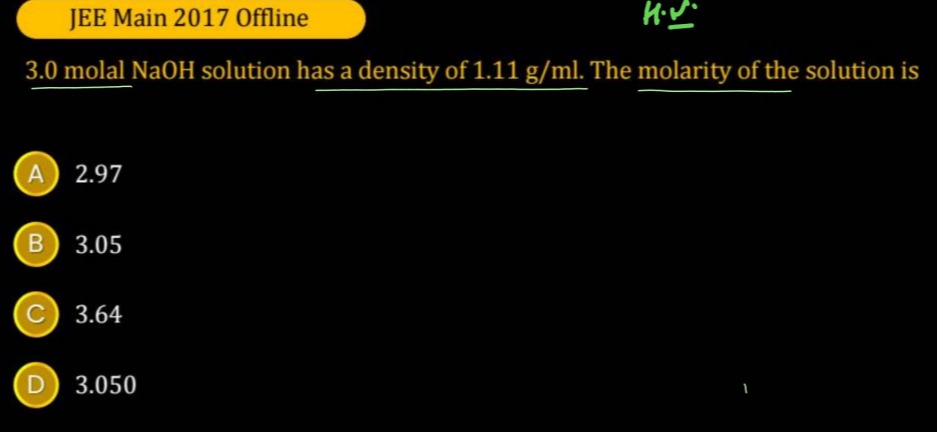Question
Question: 3.0 molal NaOH solution has a density of 1.11 g/ml. The molarity of the solution is...
3.0 molal NaOH solution has a density of 1.11 g/ml. The molarity of the solution is

2.97
3.05
3.64
3.050
2.97
Solution
Let's solve the problem using the definitions of molality and molarity.
Molality (m) is defined as the number of moles of solute per kilogram of solvent. Given molality = 3.0 molal. This means there are 3.0 moles of NaOH solute in 1 kg (1000 g) of solvent.
The solute is NaOH. The molar mass of NaOH (Mo) is the sum of the atomic masses of Na, O, and H. Mo(NaOH)=Atomic mass of Na+Atomic mass of O+Atomic mass of H Mo(NaOH)=23.0 g/mol+16.0 g/mol+1.0 g/mol=40.0 g/mol.
Mass of solute = number of moles of solute × molar mass of solute Mass of NaOH = 3.0 mol × 40.0 g/mol = 120 g.
Mass of solvent = 1000 g (from the definition of 3.0 molal solution).
Mass of solution = Mass of solute + Mass of solvent Mass of solution = 120 g + 1000 g = 1120 g.
Density of the solution is given as 1.11 g/ml. Density (d) = Volume of solutionMass of solution. Volume of solution = DensityMass of solution Volume of solution = 1.11 g/ml1120 g=1.111120 ml.
Molarity (M) is defined as the number of moles of solute per liter of solution. Number of moles of solute = 3.0 mol. Volume of solution in liters = 1000Volume in ml Volume of solution in liters = 10001120/1.11 L=1.11×10001120 L=11101120 L.
Molarity (M) = Volume of solution in litersNumber of moles of solute M = 11101120 L3.0 mol=11203.0×1110 mol/L. M = 1123×111 mol/L=112333 mol/L.
Now, we calculate the numerical value: 112333≈2.973214...
Comparing this value with the given options, the calculated value 2.9732 is closest to 2.97.
Alternatively, we can use the formula relating molarity (M), molality (m), density (d), and molar mass of solute (Mo): M=1000+m×Mo1000×m×d Given: m = 3.0 mol/kg, d = 1.11 g/ml, Mo = 40.0 g/mol. M=1000+3.0×40.01000×3.0×1.11 M=1000+120.03330 M=1120.03330 M=11203330=112333≈2.9732...
Rounding to two decimal places, the molarity is 2.97 M.
